Glossop Tramways
History
Although the idea of a local man, Glossop's small tramway system was promoted by the Urban Electric Supply Company, which would also go on to build Camborne and Redruth Tramways, both systems being operated directly rather than through subsidiary companies. The UESCo was itself a subsidiary of Edmundson's Electricity Corporation, which owned and/or controlled numerous electricity supply companies across the country, along with another tramway — Scarborough Tramways — which was operated through yet another subsidiary, the Scarborough Tramways Company.
Powers to construct an electric tramway between Glossop, Old Glossop, Charlestown, Dinting and Hadfield were granted to the UESCo on the 9th August 1901 by the Glossop Electric Tramways Order, which was confirmed by parliament under the umbrella of the Tramways Orders Confirmation (No.4) Act, 1901. Work on constructing the system did not commence for another year — in July/August 1902 — the official opening taking place one year later on the 20th August 1903; however, as there had been a delay in the Board of Trade inspection, the system was not actually opened to the general public until the following day, the 21st August 1903.
The tramway remained 'as built', and despite hopes of a connection to the municipally operated Stalybridge, Hyde, Mossley and Dukinfield Tramways, which was circa two miles distant at its closest point, the gap was never closed. The 4ft 8½ins-gauge overhead electric tramway was 4.56 miles long, and comprised a long main line from a terminus outside the Queens Arms Hotel in Old Glossop, from where it ran southwards to High Street East in Glossop, then westwards through Glossop town centre, before gradually curving northwestwards through Dinting to Woolley Bridge, whereupon it turned northeastwards then eastwards to a terminus outside the Palatine and Railway Hotel in Station Street, Hadfield. Due to the nature of the valleys it traversed, the two main termini were only 1.4 miles apart as the crow flies. There was also a short half-mile branch from the main line, which ran southwards from the centre of Glossop to a terminus outside Whitfield Lodge gates in Charlestown.
Although the tramway started well, there were always questions over its viability, given that it served a population of only 22,000, and one which was also heavily dependent on the cotton industry, passenger numbers being heavily impacted by depressions in that particular trade. Financial details are sketchy, but the fact that the company failed to pay a dividend between 1910 and 1920 is probably the most telling. Although profits were certainly made, they were very modest, and were certainly not enough to cover tramcar and track renewal, let alone give the investors a return on their outlay. The system started out with just seven tramcars, the fleet being expanded by just two vehicles, one to work the Charlestown branch in 1904, and a second-hand tramcar (from Sheffield Corporation Tramways) in early 1918. Unusually, some of these vehicles eventually had the destination painted on their dashes, probably after the 1904 tramcar arrived, which was expressly purchased to operate the branch line.
Like most tramway systems, Glossop Tramways emerged from the depredations of the Great War, with its heavy war-time loadings, minimal maintenance and investment, and manpower shortages, with a large backlog of repairs and expensive renewals. Even during the war, the company seems to have used a request by the Board of Trade in 1918 (to all tramways) to reduce mileage, and thereby save coal, to close the Charlestown branch line, ostensibly temporarily, though it turned out to be permanently. This was probably much to the company's relief given that the branch lost money, even with a one-man operated car. Although the closure would certainly have been open to a legal challenge from Glossop Town Council, they meekly acquiesced, which probably tells us everything we need to know about how poorly patronised the branch line was.
In the inflationary post-war period, and with significant track renewal, overhead line and other major costs in the offing, the UESCo attempted to divest itself of its badly run-down system by offering to sell it to Glossop Town Council (in June 1920). The offer was unsurprisingly declined, as was a subsequent offer to hand it over free of charge (in 1927), provided that the council would purchase electricity from the UESCo. The latter offer was once again refused, so with the tramway now suffering bus competition, and with its infrastructure in a parlous state, the company summarily closed the tramway, the last tram running on Christmas Eve 1927.
Uniforms
Tramcar crews were initially issued with double-breasted, lancer-style tunics with five pairs of buttons and stand-up collars; the latter carried an employee number on the bearer's left-hand side and ‘U E S Co’ on the right-hand side, in individual metal numerals/letters; the badges were probably brass to match the buttons (see link). Curiously, although staff of the UESCo's only other system (Camborne and Redruth Tramways) had similar insignia, that system's badges bore a number prefix ('No') before the employee number, and a 'LTD' suffix after the company initials (see link). The tensioned-crown peaked caps bore script-lettering grade badges, either 'Motorman' or 'Conductor', which were presumably brass to match the buttons.
At some point, probably in the mid-Edwardian era, a change was made to a heavy duty, single-breasted design of jacket with five buttons, two hip-level pockets and high, fold-over collars; the latter probably carried the same insignia as previously. The jackets were changed again not long afterwards (probably in the late-Edwardian era) to a new design, still single-breasted, but with two breast pockets, stand-up collars and epaulettes; the latter were closed with a button fastening and were left plain, i.e., without badges of any description. An employee number continued to be worn on the bearer's left-hand collar, and 'U E S Co' on the right.
Motormen (and possibly conductors too) were also issued with double-breasted greatcoats; these bore plain black buttons and were seemingly devoid of insignia.
Photographs of inspectors are rare, and are only available from the earliest years of the system; nevertheless, they do appear to show that this grade wore identical uniforms to tramcar crews, but with the grade — 'Inspector' — on the cap. This unusual practice was also repeated at the UESCo's other system, Camborne and Redruth Tramways.
Three photographs have also survived that show a more senior uniformed member of staff, i.e., the tramway superintendent. The earliest photographs show this individual wearing a double-breasted jacket with a single breast pocket, and lapels; no insignia of any kind appears to have been worn on the jacket. The cap was identical to those worn by tramcar crews, but without a badge, and with an elaborate hat band. The latest of the photographs show the superintendent in a single-breasted jacket with lapels. which clearly bear a badge of some description, possibly his grade. By this time (the late-Edwardian era), the superintendent's cap had been changed to a drooping-peak type; it is unclear what cap badge, if any, it carried.
Somewhat surprisingly for such a small provincial system, a number of excellent photographs of conductresses have survived. These ladies were employed during the Great War to replace male staff lost to the armed services. All three photographs (see below) show the subjects wearing long, tailored, single-breasted top coats with five buttons, a waist belt and high fold-over collars; the latter carried an employee number on the left-hand side and individual 'U E S Co' initials on the right-hand side. The ladies were also issued with felt bonnets and baggy caps, the latter often referred to as motor caps, presumably for summer and winter wear, respectively; although the bonnets carried a hat band, neither they nor the baggy caps bore a badge of any kind.
Further reading
Much of the background information on the photos below has been gleaned from 'Glossop Tramways' by Barry M Marsden; Foxline Publishing (1991).
Images
Motormen and conductors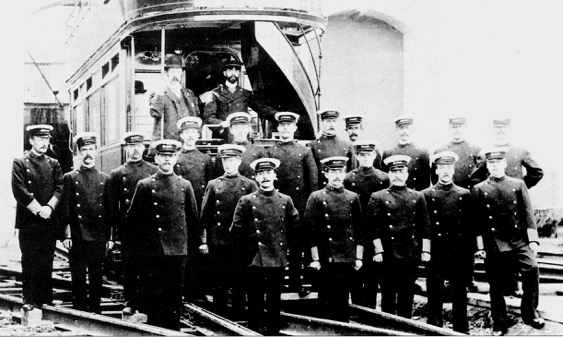
A staff photograph taken at Dinting Depot in 1903, almost certainly on, or shortly before, the opening day. The tramcar staff are wearing white rain covers on their caps, which was a summer requirement on many tramways. The man at the controls is the tramway's superintendent, Mr Emmett, whilst to his right is the General Manager, Charles Knowles (holding the upright stanchion). Photo courtesy of the Tramways and Light Railway Society, with thanks to David Voice.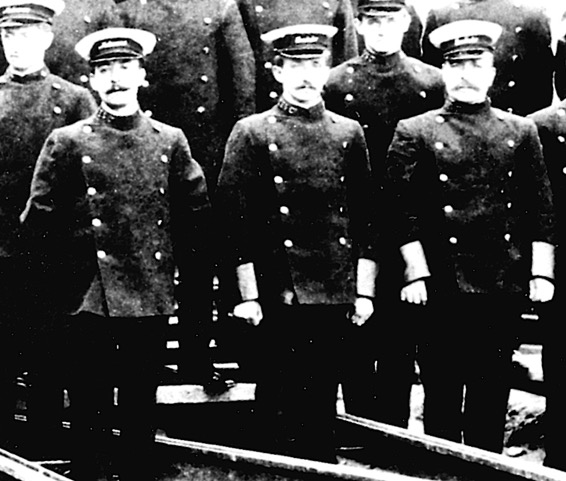
An enlargement of the above photograph showing the collar insignia, 'U E S Co' (bearer's right-hand side) and an employee number (left-hand side). The cap badges are of the standard, off-the-shelf, script-lettering grade variety.
General pattern script-lettering cap badges — 'Motorman' and 'Conductor' — of the type used by Glossop Tramways. The badges were probably brass to match the buttons (see link). Author's Collection.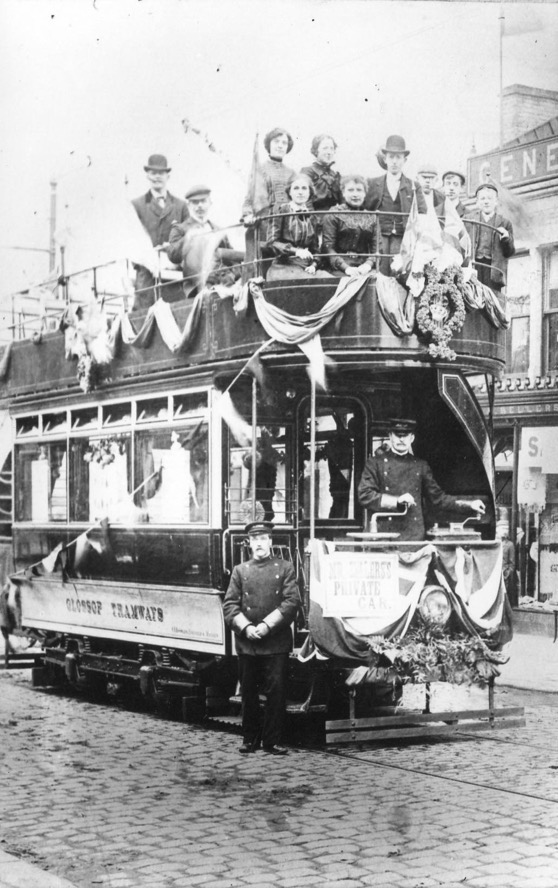
A tramcar crew pose with a decorated tramcar — hired by a Mr Sellars, the owner of a drapery business in the town — purportedly on the official opening day of the tramway, the 20th August 1903. Photo courtesy of the Tramways and Light Railway Society, with thanks to David Voice.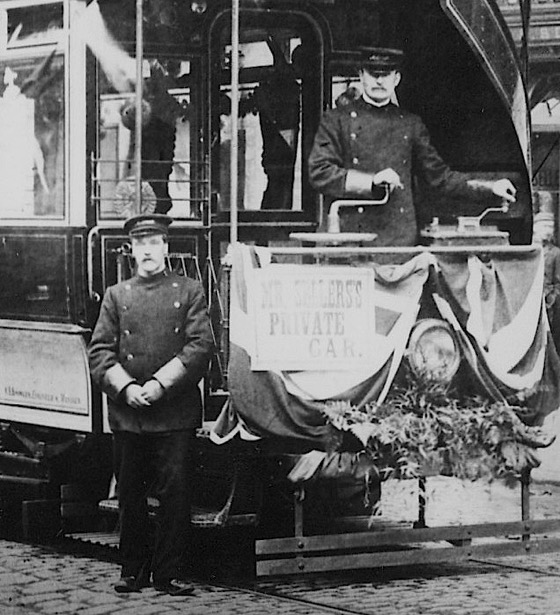
An enlargement of the above photograph, which is not quite as it seems. The motorman (Employee No 1) is actually the man standing to the left (Mr J W Phair), whilst the man at the controls is believed to be an inspector, no conductor being necessary as the car was hired. 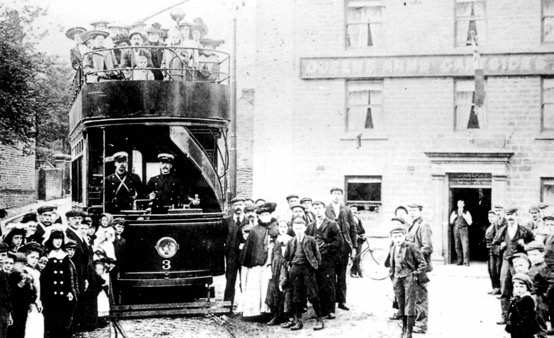
A shot which was definitely taken on the first day of passenger operation (21st August 1903), this time of Tramcar No 3 at the Old Glossop terminus. Photo courtesy of the Tramways and Light Railway Society, with thanks to David Voice.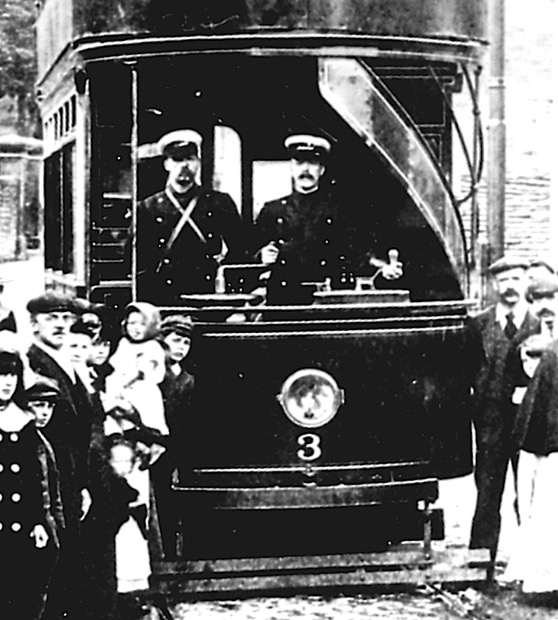
An enlargement of the above photograph showing the conductor and the motorman; the former was apparently called 'Masher' Howard. 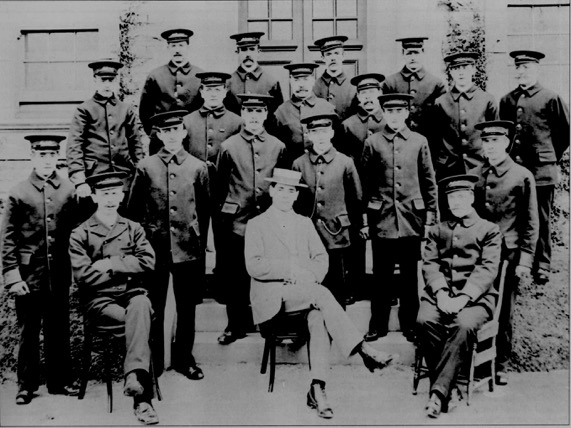
A staff photograph — undated, but probably taken in the mid-Edwardian era. There had clearly been a change of jacket style since the opening, though curiously, all the jackets are completely devoid of insignia. Photo courtesy of the Tramways and Light Railway Society, with thanks to David Voice.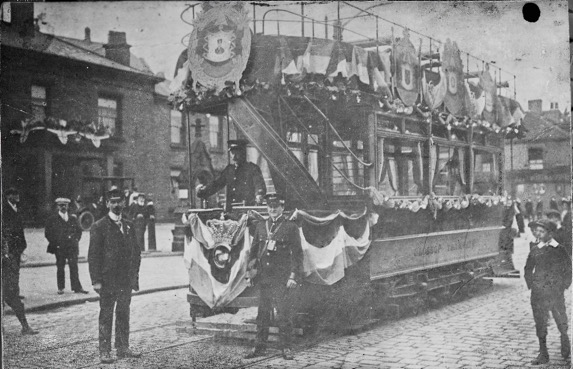
An unidentified, heavily decorated tramcar standing outside the Norfolk Arms in Norfolk Square in the centre of Glossop — photo undated, but probably taken in the late-Edwardian era. Author's Collection.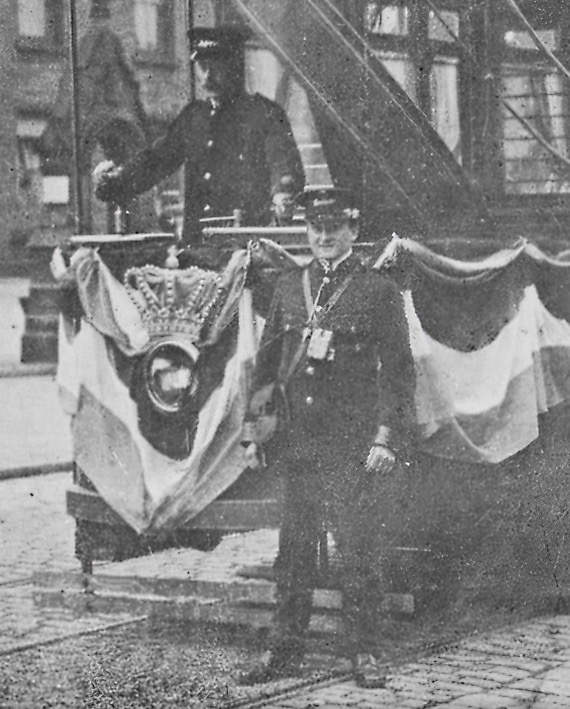
An enlargement of the above photograph showing the motorman and the conductor. By this time, the uniform had clearly changed to a single-breasted design with epaulettes and stand-up collars. 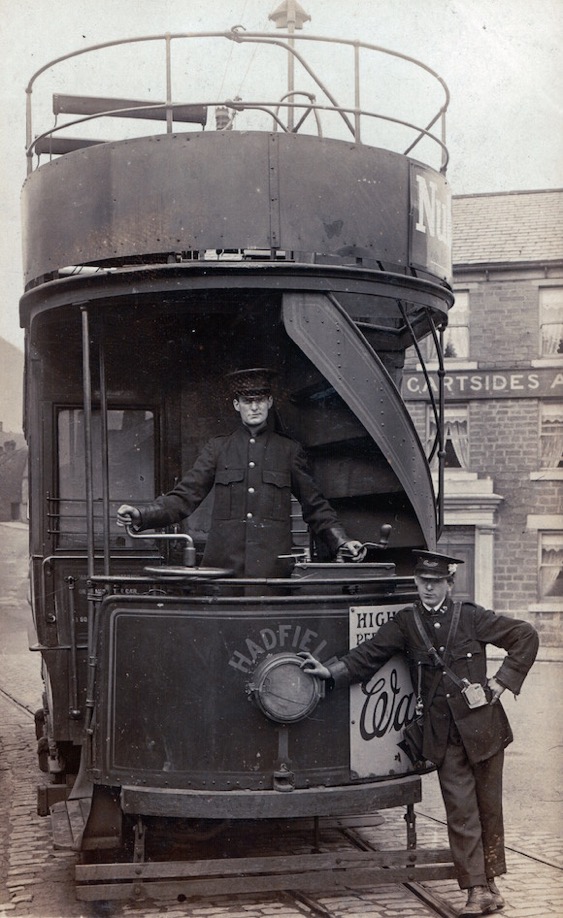
Another photograph taken at the Old Glossop terminus, this time of Tramcar No 1 — although the photograph is undated, the photographer (J W Ingham of Glossop) only appears to have been active in 1912/13. For some reason, the motorman's jacket collars are missing the usual insignia. Photo courtesy of Karen Burns.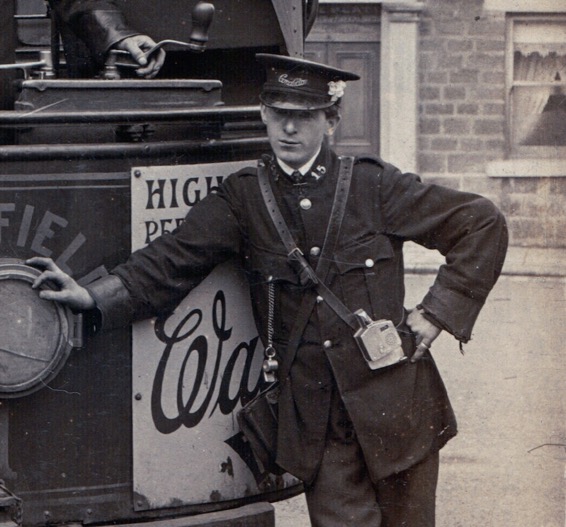
An enlargement of the above photograph showing details of the conductor's uniform; he is Employee No 15. The jacket collars carry the same insignia as previous designs, i.e., employee number on the bearer's left-hand side and company initials on the right.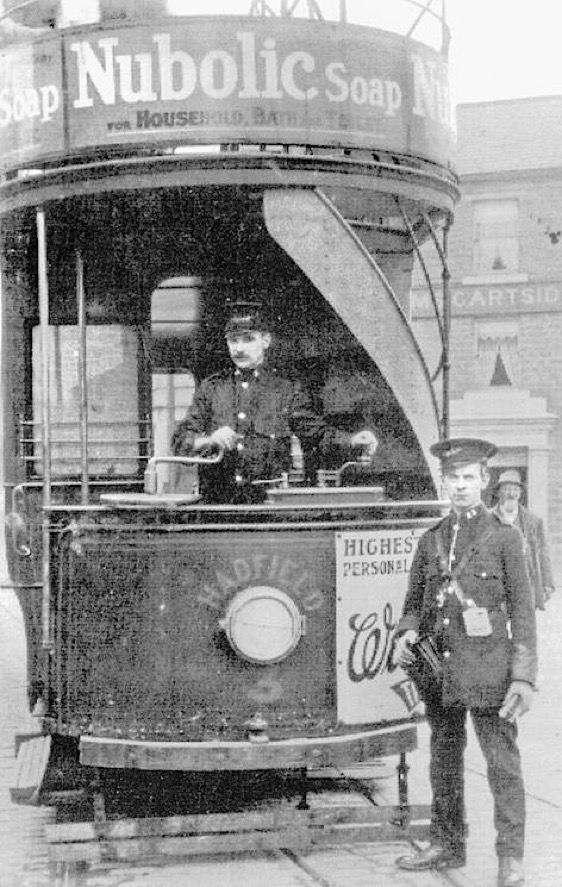
The crew of a rather run-down looking Tramcar No 3 at the Old Glossop terminus — photo undated, but probably taken around the time of the Great War. Photo and background information courtesy of the Barry Marsden Collection.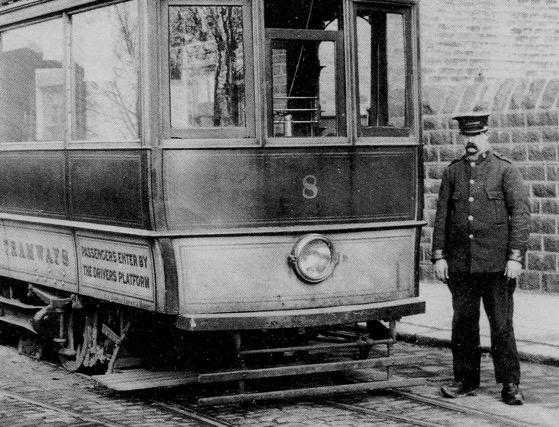
Motorman John Byrom poses with Tramcar No 8 at the Charlestown Road terminus — photo undated, but certainly taken before the end of the Great War, when this route was closed. Photo courtesy of the Tramways and Light Railway Society, with thanks to David Voice.
Senior staff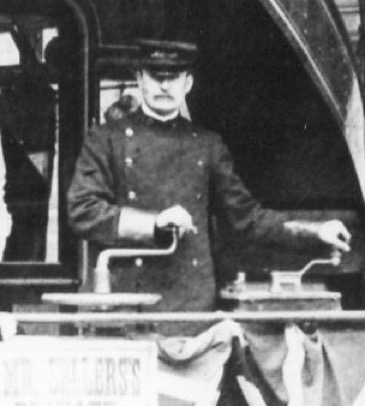
An enlargement of the decorated tramcar photograph above, showing the man at the controls, who was purportedly an inspector. If true, then it strongly suggests that inspectors wore the same uniforms as tramcar staff, bar the cap badge.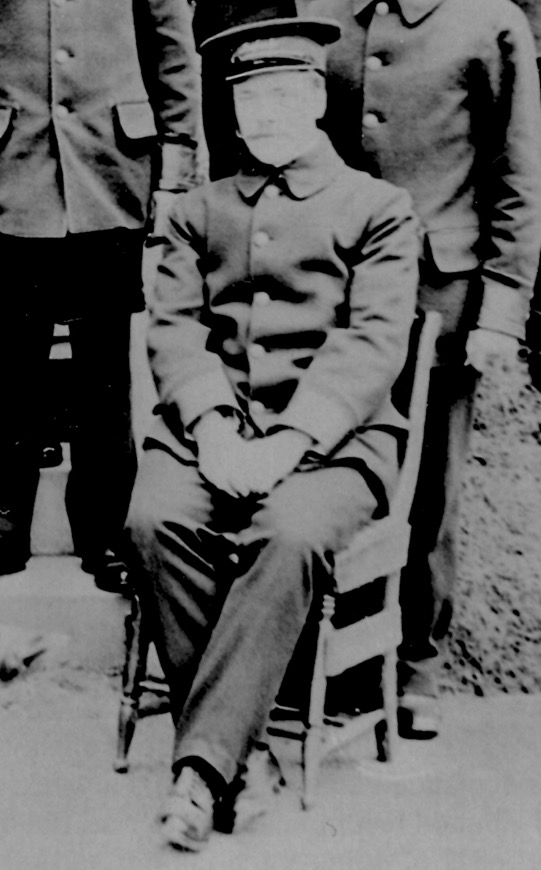
An enlargement of the mid-Edwardian staff photograph above showing an inspector. Like the rest of the subjects in the photograph, his jacket bears no insignia, the sole nod to his authority being the grade badge on his cap.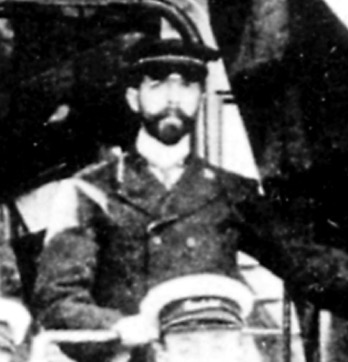
Another blow-up of the 1903 staff photograph above, this time showing Superintendent Emmett. It is unclear whether the cap carried a badge or not.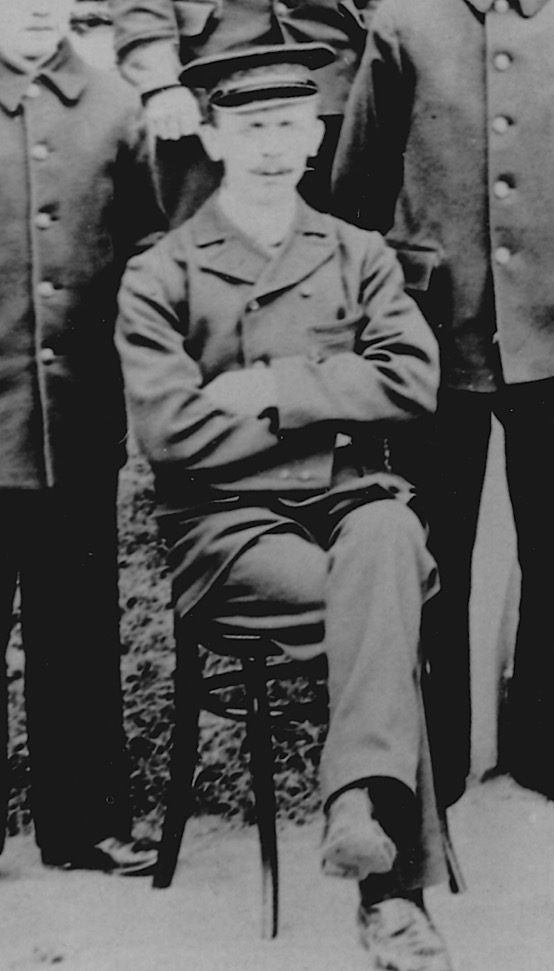
Another blow-up of the mid-Edwardian staff photograph above, this time showing the superintendent. His cap, although provided with an elaborate hat band, does not appear to bear a badge.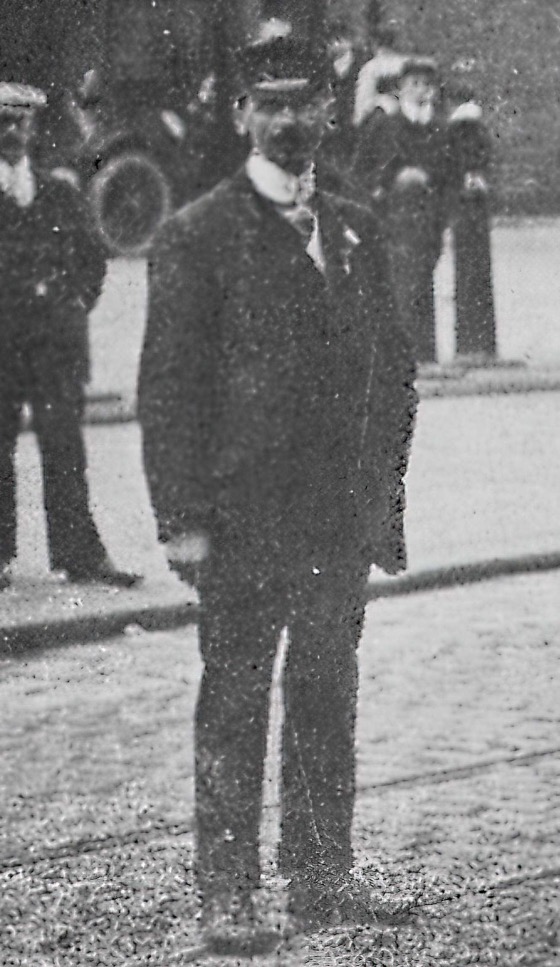
An enlargement of the decorated tram photograph above showing an individual who is, in all probability, Superintendent Emmett. He is wearing a single-breasted jacket with lapels, and a drooping-peak cap.
Female staff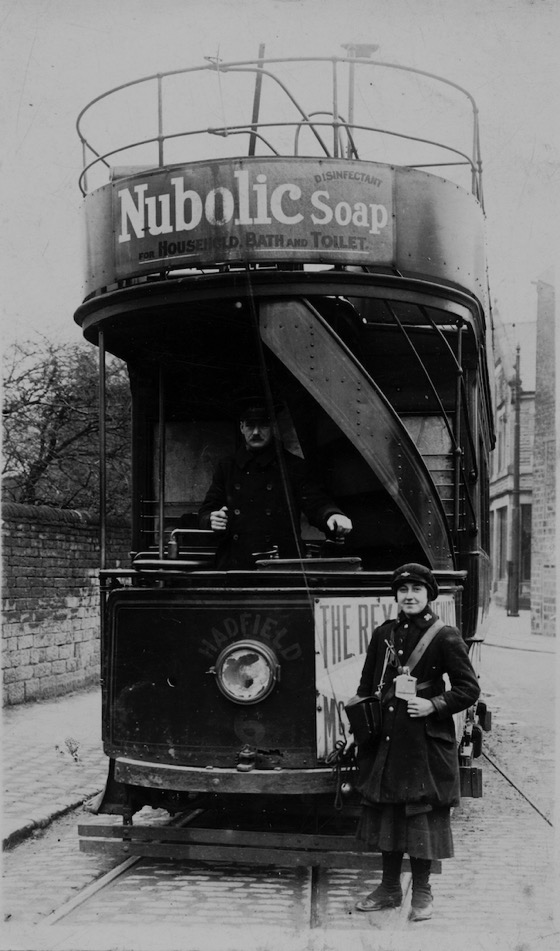
A motorman and a conductress pose with Hadfield Tram No 6 outside the Queens Arms pub at the Old Glossop terminus — photo undated, but almost certainly taken during the Great War. Photo courtesy of Glossop Heritage Trust, with thanks to Mike Brown.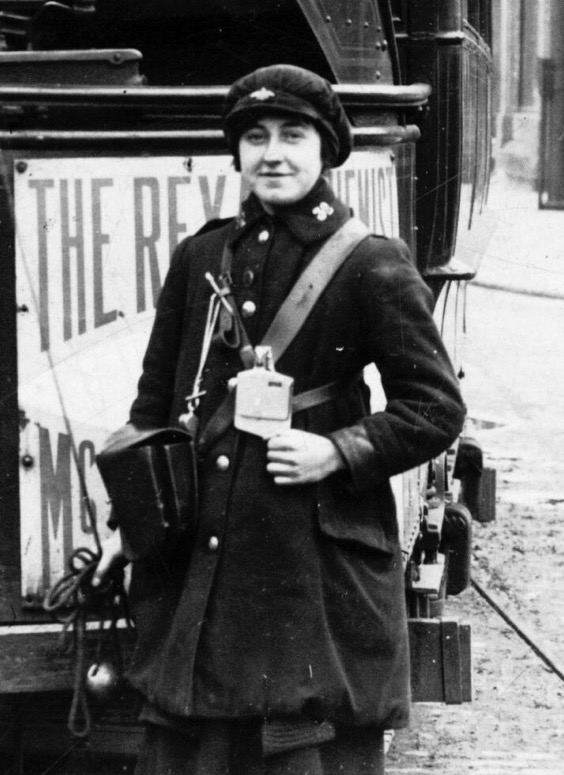
An enlargement of the above photograph showing the conductress — Employee No 32. The cap badge is almost certainly a regimental sweetheart badge (possibly The Royal Flying Corps), the wearing of which was common practice during the Great War.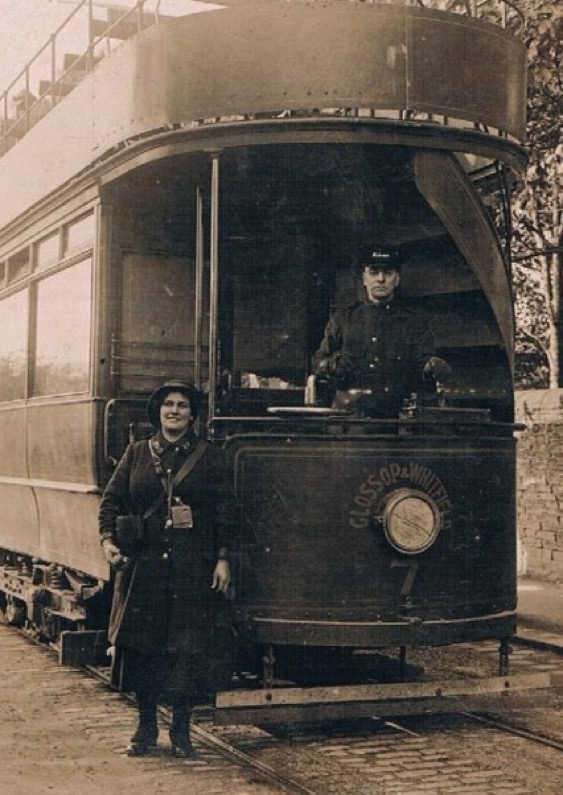
A conductress and a motorman (Aaron Howard) pose for the cameraman with Glossop & Whitfield Tram No 7 — photo undated, but almost certainly taken during the Great War. Photo courtesy of Glossop Heritage Trust, with thanks to Mike Brown.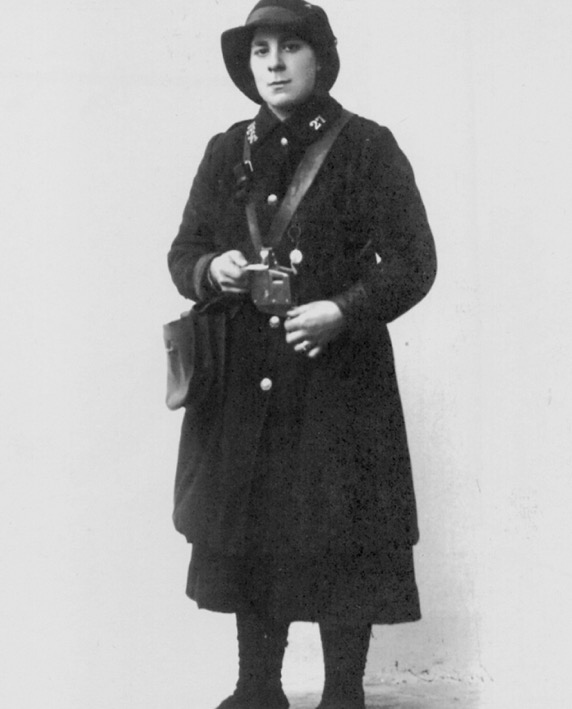
Conductress Alice Lee (Employee No 27), captured in 1916. Alice Lee was the wife of Motorman Henry Lee, who at the time the photograph was taken, was serving abroad with the armed forces. Photo courtesy of the Tramways and Light Railway Society, with thanks to David Voice.